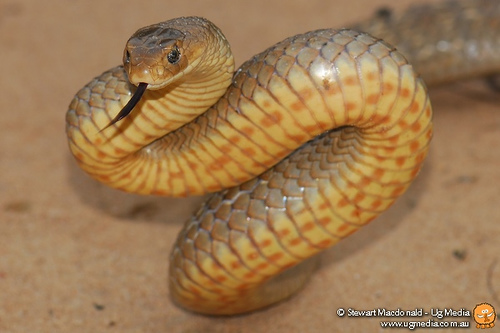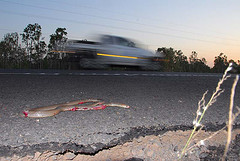
Interactions with Other Species
Eastern brown snakes are known for their very potent
venom which to humans automatically gives them a bad
reputation. In reality the eastern brown snake is great
for rodent control.
Mus musculus
and relatives of the
Cavia porcellus are just a few of the many rodents in which
the snake eats. However, if the Eastern Brown Snake was
to try to consume a
Cane Toad which are found throughout Australia the
result for the snake is usually fatal.
It is studied that some feral cats have developed
immunity to the snake’s venom, which makes these snakes
an easy meal for the cats. Other mammals, however, are
not quite so lucky when they encounter the eastern brown
snake for it has the second most potent venom of any
snake in the world. The only snake with more potent
venom is the
inland taipan which some people consider to
be less potent than the eastern brown.
Many
organisms in Australia compete for the same food and
living space with the eastern brown snake. Many birds of
prey such as
hawks and
falcons
enjoy a nice meal of the same animals as the brown snake. This would generally
create great competition over food, but since the rodent
population is extremely high there is little competition
over food sources.
Interactions with humans
The eastern brown snake is the leading cause of death by
snake bites in Australia with about two deaths recorded
per year. There are on average around 3000 snake bites
recorded per year with many of them being from the brown
snake. The reason for the high rate of snake bites per
year is because the snake resides in semi-populated
areas.
 This snake can be found dead on the side of many
roads in Australia, and vehicles are a main source of
death for this snake. The brown snake is generally a
solitary animal and will not readily attack humans, but
will attack if it feels threatened. Unlike the
spitting
cobras, the brown snake is unable to spray its venom
in order to protect itself; it has to inject its venom
through its fangs into the human to protect itself.
This snake can be found dead on the side of many
roads in Australia, and vehicles are a main source of
death for this snake. The brown snake is generally a
solitary animal and will not readily attack humans, but
will attack if it feels threatened. Unlike the
spitting
cobras, the brown snake is unable to spray its venom
in order to protect itself; it has to inject its venom
through its fangs into the human to protect itself.